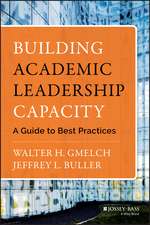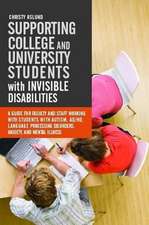Critical Race Spatial Analysis: Mapping to Understand and Address Educational Inequity
Editat de Deb Morrison, Subini Ancy Annamma, Darrell D. Jacksonen Limba Engleză Paperback – 11 apr 2017
| Toate formatele și edițiile | Preț | Express |
|---|---|---|
| Paperback (1) | 317.01 lei 6-8 săpt. | |
| Taylor & Francis – 11 apr 2017 | 317.01 lei 6-8 săpt. | |
| Hardback (1) | 1003.30 lei 6-8 săpt. | |
| Taylor & Francis – 19 apr 2017 | 1003.30 lei 6-8 săpt. |
Preț: 317.01 lei
Nou
Puncte Express: 476
Preț estimativ în valută:
60.67€ • 63.10$ • 50.08£
60.67€ • 63.10$ • 50.08£
Carte tipărită la comandă
Livrare economică 14-28 aprilie
Preluare comenzi: 021 569.72.76
Specificații
ISBN-13: 9781620364246
ISBN-10: 1620364247
Pagini: 190
Dimensiuni: 178 x 254 x 13 mm
Greutate: 0.31 kg
Ediția:1
Editura: Taylor & Francis
Colecția Routledge
Locul publicării:Oxford, United Kingdom
ISBN-10: 1620364247
Pagini: 190
Dimensiuni: 178 x 254 x 13 mm
Greutate: 0.31 kg
Ediția:1
Editura: Taylor & Francis
Colecția Routledge
Locul publicării:Oxford, United Kingdom
Public țintă
PostgraduateCuprins
Part One. Introduction 1. Searching for Educational Equity Through Critical Spatial Analysis—Subini Ancy Annamma, Deb Morrison, and Darrell D. Jackson 2. Critical Race Spatial Analysis. Conceptualizing GIS as a Tool for Critical Race Research in Education—Verónica N. Vélez and Daniel G. Solórzano Part Two. Case Methodologies and Tools 3. Disrupting Cartographies of Inequity. Education Journey Mapping as a Qualitative Methodology—Subini Ancy Annamma 4. Reframing Traditional Geospatial Methods and Tools for Use in Educational Inequity Research and Praxis—Deb Morrison and Graham S. Garlick 5. Predatory Landscapes. Pedagogical and Social Justice Tools to Uncover the Racist Nativism in the Spatial Dimensions of Economic Exclusion—Leigh Anna Hidalgo Part Three. Case Examples 6. Using Critical Race Spatial Analysis to Examine Redlining in Southern California Communities of Color, Circa 1939—Daniel G. Solórzano amd Verónica N. Vélez 7. Resisting Redlining in the Classroom. A Collaborative Approach to Racial Spaces Analysis—Benjamin Blaisdell 8. Exploring Educational Opportunity With Geospatial Patterns in High School Algebra 1 and Advanced Mathematics Courses—Mark C. Hogrebe & William F. Tate IV 9. Geospatial Perspectives on Neoliberal Education Reform. Examining Intersections of Ability, Race, and Social Class—Federico R. Waitoller & Joshua Radinsky Conclusion 10. Critical Spatial Analysis in Education. Today and Tomorrow—Deb Morrison, Subini Ancy Annamma, and Darrell D. Jackson About the Contributors Index
Notă biografică
Deb Morrison is with TREE Educational Services. Subini Ancy Annamma teaches at the University of Kansas. Darrell D. Jackson teaches at the University of Wyoming.
Recenzii
“The growth of critical race studies has prompted huge advances in our understandings of the numerous complex, shifting and often hidden ways in which racism operates in the contemporary world. This ground-breaking volume brings together cutting-edge scholarship that applies the principles and inspiration of critical race theory (CRT) to critical spatial analyses. The result is a provocative and fascinating collection that will have a lasting impact on the field.”
David Gillborn, Director, Centre for Research in Race & Education
University of Birmingham
"Critical Race Spatial Analysis (CRSA) is an intellectually captivating text. The use of practical, real life examples and accessible language are ideal for beginners in critical race studies, providing them conceptual and empirical anchors to develop multi-scalar investigations for diverse contexts. Theoretically rich and methodologically sound studies feature both nuanced and comprehensive complexities, compelling the more experienced to envision novel interstices. CRSA is an inspiration, an impetus to rethink and retool efforts that address educational inequities.
Eileen R. Carlton Parsons, PhD, Professor, Science Education
University of North Carolina at Chapel Hill
"The editors and chapter authors of Critical Race Spatial Analysis have taken it upon themselves to embark upon a bold challenge: to fulfill the interdisciplinary charge of Critical Race Theory. For now and into the distant future, their work stands as testament to the commitment to grapple with the layers of race, space and school. In the long road towards justice, I am overly grateful to my comrades for producing this seminal volume."
David Stovall, Ph.D., Professor of Educational Policy Studies and African-American Studies
University of Illinois at Chicago
“In their edited work, Morrison, Annamma, and Jackson make a compelling case for the necessity to include a critical spatial lens in educational research. In making their argument, the authors build upon the work of Soja, who used the term spatial justice to highlight the benefits of thinking about justice through a spatial lens. The purpose of the book is ‘to examine racial inequities in education through a critical spatial lens, situating the spatial temporally and socially’. The editors achieve this goal over the course of ten chapters that explain critical race spatial analysis (CRSA) and offer a variety of methodologies and examples of how to carry out CRSA in education research.
Critical Race Spatial Analysis is a necessary and timely text. [It] succeeds in its purpose and makes a strong case for paying greater attention to the ways spaces are racialized, and how this in turn plays a role in reproducing educational inequities. The greatest strength of the book is in noting the numerous methods and methodologies to merge spatial analysis with critical race theory. As the authors note, the text should not serve as an introduction to geospatial studies or critical race theory. However, it will serve as a powerful introduction for scholars seeking to work at the intersection of these fields. The text also offers terrific examples of how to incorporate rigorously critical methodological and theoretical perspectives into one’s work, which may be useful to scholars in an array of disciplines. As such, we highly recommend this text to all who are interested in exposing and eradicating educational inequities.”
Teachers College Record
David Gillborn, Director, Centre for Research in Race & Education
University of Birmingham
"Critical Race Spatial Analysis (CRSA) is an intellectually captivating text. The use of practical, real life examples and accessible language are ideal for beginners in critical race studies, providing them conceptual and empirical anchors to develop multi-scalar investigations for diverse contexts. Theoretically rich and methodologically sound studies feature both nuanced and comprehensive complexities, compelling the more experienced to envision novel interstices. CRSA is an inspiration, an impetus to rethink and retool efforts that address educational inequities.
Eileen R. Carlton Parsons, PhD, Professor, Science Education
University of North Carolina at Chapel Hill
"The editors and chapter authors of Critical Race Spatial Analysis have taken it upon themselves to embark upon a bold challenge: to fulfill the interdisciplinary charge of Critical Race Theory. For now and into the distant future, their work stands as testament to the commitment to grapple with the layers of race, space and school. In the long road towards justice, I am overly grateful to my comrades for producing this seminal volume."
David Stovall, Ph.D., Professor of Educational Policy Studies and African-American Studies
University of Illinois at Chicago
“In their edited work, Morrison, Annamma, and Jackson make a compelling case for the necessity to include a critical spatial lens in educational research. In making their argument, the authors build upon the work of Soja, who used the term spatial justice to highlight the benefits of thinking about justice through a spatial lens. The purpose of the book is ‘to examine racial inequities in education through a critical spatial lens, situating the spatial temporally and socially’. The editors achieve this goal over the course of ten chapters that explain critical race spatial analysis (CRSA) and offer a variety of methodologies and examples of how to carry out CRSA in education research.
Critical Race Spatial Analysis is a necessary and timely text. [It] succeeds in its purpose and makes a strong case for paying greater attention to the ways spaces are racialized, and how this in turn plays a role in reproducing educational inequities. The greatest strength of the book is in noting the numerous methods and methodologies to merge spatial analysis with critical race theory. As the authors note, the text should not serve as an introduction to geospatial studies or critical race theory. However, it will serve as a powerful introduction for scholars seeking to work at the intersection of these fields. The text also offers terrific examples of how to incorporate rigorously critical methodological and theoretical perspectives into one’s work, which may be useful to scholars in an array of disciplines. As such, we highly recommend this text to all who are interested in exposing and eradicating educational inequities.”
Teachers College Record
Descriere
This book addresses these questions and explores the use of critical spatial analysis to uncover the dimensions of entrenched and systemic racial inequities in educational settings and identify ways to redress them.






